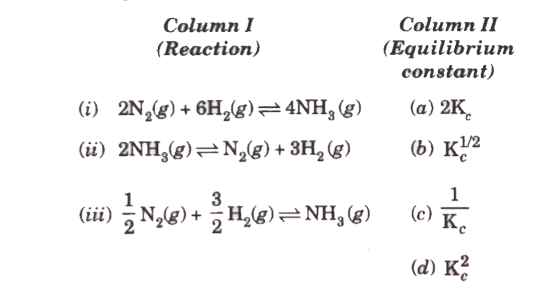Equilibrium mixture (I) consists of N2, H2, and NH3. Equilibrium mixture (II) consists of N2, D2, and ND3. Which of the following observations is correct if both the mixtures (I and II) are mixed together and left for a while?
The concentration of NH3 is just the same as before.
Ammonia and all deuerium-containing forms of ammonia (NH2D,NHD2, and ND3) are present.
Dihydrogen and all deutrated forms (HD and D2) are present.
All of these
The correct Answer is:D
Chemical equilibrium is dynamic in nature, i.e., both forward and reverse reactions are still going on but at equal rates. Scrambling of H and D atoms in the molecules results from a continuation of the forward and backward reactions in the mixture. If the reactions has simply stopped when they reached equilibrium, then there would have been no mixing of isotopes in this way. Thus, the use of isotope (deuterium) in the formation of ammonia clearly indicates that chemical equilibrium is dynamic in nature.
Topper's Solved these Questions
- BOOK - R SHARMACHAPTER - EQUILIBRIUMEXERCISE - Follow-up Test 313videos
EQUILIBRIUM
- BOOK - R SHARMACHAPTER - EQUILIBRIUMEXERCISE - Follow-up Test 410videos
EQUILIBRIUM
- BOOK - R SHARMACHAPTER - EQUILIBRIUMEXERCISE - Follow-up Test 110videos
EQUILIBRIUM
- BOOK - R SHARMACHAPTER - CLASSIFICATION OF ELEMENTS AND PERIODICITY IN ELEMENTSEXERCISE - ARCHIVES37videos
CLASSIFICATION OF ELEMENTS AND PERIODICITY IN ELEMENTS
- BOOK - R SHARMACHAPTER - GENERAL ORGANIC CHEMISTRYEXERCISE - Archives36videos
GENERAL ORGANIC CHEMISTRY
Similar Questions
The vapour density of mixture consisting of NO2 and N2O4 is 38.3 at 26.7∘C. Calculate the number of moles of NO2 I 100g of the mixture.
View SolutionAt 207∘C, for the reaction :
N2(g)+3H2(g)⇔2NH3(g)
it is found that at equilibrium, the mixture contains 52% of ammonia. If the pressure of the mixture is 10 atm, calculate Kp and Kc for the reaction.View Solution
Knowledge Check
- Question 1 - Select One
N2+3H2⇔2NH3
Which of the following statements is correct if N2 added at equilibrium condition?AThe equilibrium will shift in the forward firection because according to the second law of thermodynamics, the entropy must increase in the direction of the spontaneous reaction.BThe condition of equilibrium is GN2+3GH2=2GNH3, where G is the Gibbs frre energy per mole of the gaseous species measured at partial pressure. The condition of equilibrium is unafected by the use of catlyst which increases the rate of both the forward and backward reactions to the same extent.CThe catalyst will increase the rate of forward reaction by α and that of backward reaction by β.DThe catalyst will not alter the rate of either of the reactions. - Question 2 - Select One
Which of the following will not shift the equilibrium , N2+3H2⇔2NH3 towards product side ?
ACoolingBAddition of reactantsCAddition of catalystDIncreasing pressure - Question 3 - Select One or More
In a chemical reaction, N2+3H2⇔2NH3, at equilibrium point
Aequal volumes of N2andH2 are reactingBequal masses of N2andH2 are reactingCthe reaction has stoppedDthe same amount of ammonia is formed as is decomposed into N2andH2.
For the reaction
N2(g)+3H2(g)⇔2NH3(g)
Equilibrium constant Kc=[NH3]2[N2][H2]3
Some reactions are written below in column I and their equilibrium constants in terms of Kc are written in Column II. Match the following reactions with the corresponding equilibrium constant.
 View Solution
View SolutionN2+3H2⇔2NH3 If temperature of following equilibrium reaction increases, then the reaction
View SolutionFor the equilibrium N2(g)+3H2(g)⇔2NH3(g) at 10000C the equilibrium constant is very low, then which of the following is correct at equilibrium ?
View SolutionA mixture of nitrogen and hydrogen in the ratio of 1:3 reach equilibrium with ammonia, when 50% of the mixture has reacted. If the total pressure is P, the partial pressure of ammonia in the equilibrium mixture was :
View Solution20 ml of a gaseous mixture of N2 and H2 gases is mixed with 8 ml O2 and the mixture is fired.if the final volume becomes 13 ml the volume percent of N2 in the original mixture is :
View Solution

